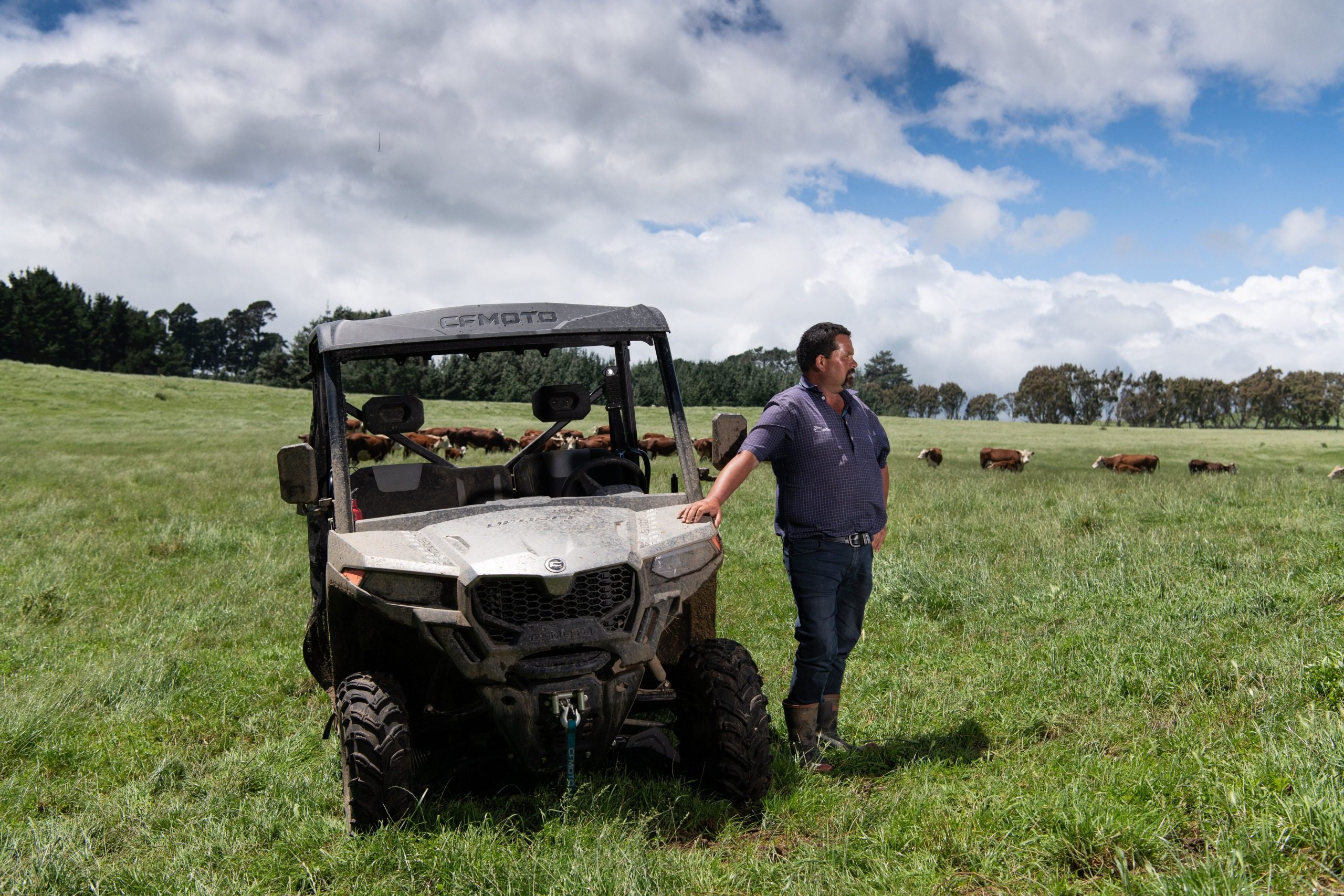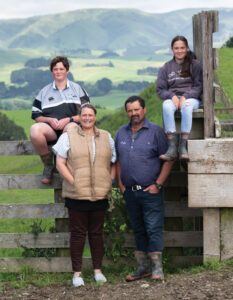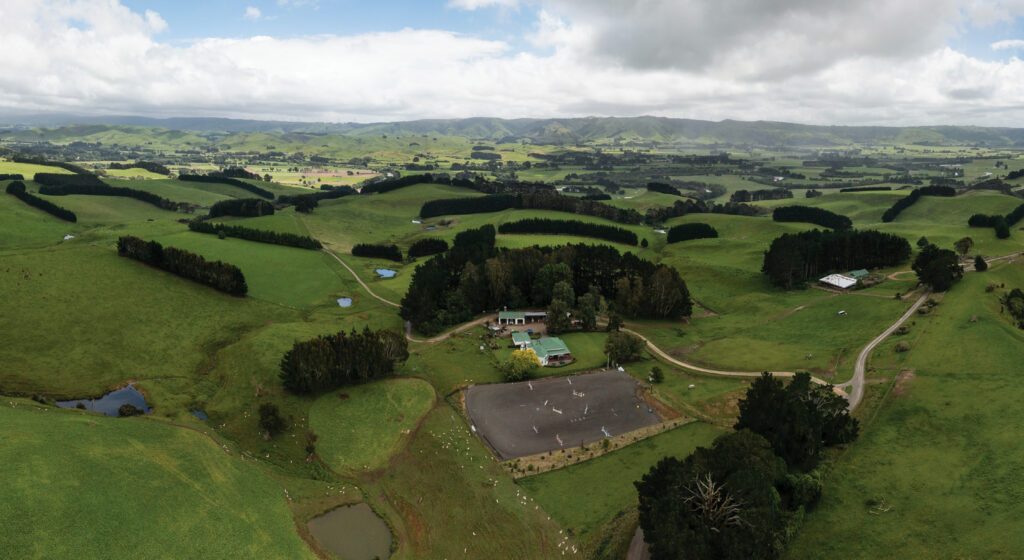Achieving a dream
The buying of Maru Farm and sale of part of their Puketawa block has allowed the King family to maximise their business development. By Russell Priest. Photos by Brad Hanson.

The buying of Maru Farm and sale of part of their Puketawa block has allowed the King family to maximise their business development. By Russell Priest. Photos by Brad Hanson.
Ronald (Ronnie) and Justine (Buzz) King had almost completed a development programme on their 1108-hectare block of difficult northern Wairarapa hill country when Country-Wide last visited in the spring of 2017.
Their success earned them the runner-up title in the 2017 Ahuwhenua Maori Farmer of the Year Award. But a lack of finishing country hindered further development of their business.
“We were farming in a summer-dry environment subject to the whims of both the store market and the weather so were vulnerable to both,” Ronnie says. “We needed more finishing country which didn’t dry out in the summer.”
After just missing out on blocks close to their farm, Puketawa, a local agent suggested a 490ha block (Maru Farm) near Mangatainoka.
They initially dismissed it, thinking it was beyond their budget, but when the farm didn’t sell, they viewed it and were pleasantly surprised by its easy contour and soils.
To buy Maru Farm, 450ha of Puketawa’s front country was sold, while the back 600ha was retained with two partners. Of this, 485ha was planted into pine trees in a joint venture project with Crown Forestry, while the balance was planted in Manuka and other natives.

“Being an absentee owner means I seldom visit the pine block, however once the pines get big enough I’ll be able to run some cattle there,” Ronnie says.
Since buying Maru in 2018, the Kings, together with children Dallas and Bridie, have bought an adjacent 170ha block giving them a total of 660ha (576ha effective) between the Mangahao River and SH2 at Mangatainoka.
The unfarmed 84ha includes pine plantations, riparian plantings and steep areas in natives including Manuka. These plants provide winter sustenance for 100-150 hives of bees for which the Kings receive $20/hive. A few hives remain on the farm over the summer.
Part of this area (42ha) is registered with the ETS, providing an income stream and an offset for the business’ own greenhouse gas emissions.
Maru Farm is a breeding and trading stock business running 6300-6500 su at 11-11.3su/ha. The trading stock component provides a safety valve to cater for annual variations in pasture growth.
Capital stock include 150 mainly Hereford cows plus 30 in-calf Hereford R2 heifers, 72 R1 Hereford heifers, 70 R1 Hereford bulls, 1850 ewes and 340 in-lamb replacement hoggets. Trading stock include 126 R2 bulls, 40 R2 steers, 70 home-reared R1 dairy cross bulls and 1000 – 1200 male lambs for winter contracts.
The breeding cow herd includes about 40 Angus which will be replaced next year with homebred Herefords. Supplying Hereford bulls to dairy farmers is the reason the Kings run Herefords with between 30-40 bulls being sold annually.
Cows groom the pasture
The 150 breeding cows groom the pastures during the spring/summer period and clean up winter roughage. Ronnie used to put more pressure on the cows over the spring/summer to stop pastures running to head, however he now uses them in conjunction with mechanical topping to achieve this.
“I was being a bit hard on the cows and they and their calves were suffering a bit, so now after they’ve been in a paddock Dallas comes in with the mower to finish the job. They still have to do a thorough job on the hills however.”
Heifers are calved as R2s with the bull going out on January 10. A low birthweight EBV bull is used for a 25-day mating period and Ronnie likes the heifers to be at least 350kg before going to the bull.
“My policy is to grow the heifers as well as I can through to calving to ensure I end up with a good-sized cow. We normally put 35 to the bull and get 30-32 in calf.”
Bull-out date for the cows is December 15 for 42 days, with the empty rate under 3% and the calving percentage in the late 90s (live calves to cows wintered).
Calving takes place behind a hot wire on pasture shut up in early August. Baleage is sometimes fed as a supplement.
When selecting herd sires Ronnie insists on them being structurally sound, polled with excellent temperament, good growth and length and with a background of strong maternal traits (ease of calving, fertility and milk).
A flock of 1850 Romney ewes are the other breeding component of the business. The Kings are justifiably proud of the ewe flock as it represents the product of a breeding programme that they started at Puketawa after buying part of Chris Bendall’s Romney stud flock.
Each year a top Indexing stud ram is bought from Chris’ son Geoff with a particular focus on facial eczema (FE) tolerance as Ronnie believes the only long-term solution to the disease is through breeding. Enough rams are bred to service their own commercial flock with those surplus to requirements sold to acquaintances.
In spite of a regular drenching programme, Ronnie struggled to achieve acceptable growth rates with the first crop of lambs on Maru Farm, leading him to do a drench reduction test. To his horror he found the farm carried worms resistant to all drench families. The response was to minimise drench use by only drenching ewes that needed it and restricting the lamb drenching programme to a triple drench after weaning, followed up with regular faecal egg counting, running lambs on crops wherever possible and using Zolvix as an exit drench in May/June.
Ronnie doesn’t hesitate to drench if high populations of Barber’s pole larvae are present.
“When we first came to Maru we were drenching every 17 days with no effect. However, now that we’ve cut back we’re starting to get on top of the problem and we’ve saved big dollars.”
Their aim is to breed sheep that are tolerant or resistant to worms, and already the Kings have made a positive start by not drenching any ram lambs out of the stud ewes while monitoring them for growth rate and dags score. If they start displaying signs of ill-thrift or dagginess they are culled. Those that make it through this rigorous culling programme form the pool of rams from which Ronnie selects his flock sires.
“This selection programme seems to be working as the constitution of our ewe flock seems to be improving.”
Stud ewe hoggets to Sufftex rams
Stud ewe hoggets are mated to Sufftex rams and they must be capable of weaning a good lamb without problems if they are to be considered as stud flock replacements as two-tooths.
A two-flock system differentiates between ewes going to Romney rams (A flock) and those going to terminal sires (cull A flock ewes, B flock and one-year ewes).
About 600-700 are mated to mainly Sufftex rams in mid-March for two cycles while 1150 A flock ewes including two-tooths go to Romney rams on April 13 for two cycles. Two-tooth ewes and MA ewes are mated and lambed together. Wet dries from the breeding flock are tagged and relegated to the B flock. If they are dry/wet-dry in the B flock they are culled. Ronnie says the number of wet dries is declining.
Average lambing percentage for the A flock is 152% with B flock and old ewes 148%.
In the past ewe hoggets were mated at between 36-40kg however Ronnie says it took him a while to realise the importance of growing hoggets as big as possible so they are able to rear a good lamb(s) and achieve good two-tooth weights.
They must now achieve a minimum weight of 40kg by May 10 to be mated. Sufftex rams are used and run with the hoggets for two cycles. Between 82% and 85% of the hoggets go to the ram achieving a lambing percentage of 105.
A refugia approach to drenching hoggets is practiced with only 2% requiring drenching.
All ewes and hoggets put to the ram are scanned with the A flock ewes scanning 186%, the B flock and old ewes 184% and the hoggets 121%.
Ewes are wintered in two mobs (A flock including two tooths and B flock with old ewes) on a 70-80-day rotation (first round) with three-day shifts. The second round involves two-day shifts then the focus is on evening-out pasture covers ready for set stocking at lambing. The rotations continue right up to lambing before the ewes are set stocked at 6-7su/ha. Rotations are briefly interrupted by scanning and pre-lamb crutching and vaccinating with 5-in-1.
B flock and old ewes start lambing in early-to-mid August.
“We lamb as early as we can but are restrained by the availability and cost of growing early-spring feed. It’s a balancing act between these two factors and the early season processing premiums for ewes and lambs.”
Lambs out of B flock and old ewes are generally weaned December 10 with 65% killed off their mothers at 17kg CW average. All old ewes are killed at the same time. Lambs from the A flock ewes are progressively weaned from mid-December through to early January with all finishing lambs going on to Hunter and raphno forage crops.
“We wouldn’t normally start weaning the A flock lambs quite as early with so much grass around, however the crops have grown so well we’ve been forced to graze them before they start losing their quality.”
Lambs are drafted every three weeks off the finishing crops with average weights being 17.5-18.5kg. Remaining lambs are faecal egg counted after each draft.
All stock are killed through Affco where the King Whanau collective is a key account holder, annually processing 10,000-12,000 lambs, 2000 ewes and 500-600 cattle. The collective includes Ronnie and Buzz, older brother Eugene and wife Pania, sister Nukuhia and husband Bart Hadfield, and sister Marama and husband Rob Papworth. Independent agent Simon Bradley of Bradley Livestock, Taumarunui, is their collective agent.

Blocks needed injection of fert
Having bought Maru Farm and the adjoining block for an average of $10,000/ha the Kings’ appetite for development was rekindled.
“Both blocks needed a decent injection of fertiliser and lime so we’ve been applying 350-420kg/ha of SurePhos and 2.5t/ha lime to get the pastures going.”
Future rates of fertiliser application will be based on soil test results carried out on GPS sites every three years to ensure sampling consistency.
Most of Maru is easy contour and covered in a mantle of well-structured Dannevirke silt loam. On the western end of the farm at its lowest point is 30ha of flood-prone alluvial soil next to the Mangahao River.
“The water floods the flats and is generally gone in 24 hours leaving little or no debris. We have an excellent monitoring system so we get plenty of warning to shift stock to higher ground.”
Last year 12ha was leased to grow maize and Ronnie hopes to continue this arrangement. Balage is harvested off part of it and because it doesn’t pug it is ideal for wintering cattle.
With half of the farm being cultivable the Kings have wasted little time in getting into a cropping rotation involving swedes, Pallaton Raphno, green-feed oats, Italian ryegrass and Hunter leafy turnip. All cropping is carried out by a local contractor and takes out 20–25ha of pasture a year. Hunter is used entirely for lamb finishing with oats, Raphno, Italian and swedes being used for feeding lambs and cattle.
“I particularly like Raphno because you can use it to feed lambs over the summer then shut it up in the autumn and break-feed it to cattle in the winter.’
Ronnie admits there are better lamb finishing crops available, however he uses it to hold lambs before finishing them on Hunter, or for holding winter-finishing lambs in the autumn. He grazes it hard five times during the summer before applying 100kg urea in May and shutting it up for six weeks before break-feeding to cattle in mid-June.
“It’s an easy crop to transition on from both Hunter and grass and once its tap root is established you can graze it to the ground.”
Sown in mid-November the Raphno establishes its tap root before being grazed around Christmas by 50-60 lambs/ha. Once they get on top of it and it recovers, the grazing number is reduced to 40/ha.
The Kings are enjoying being able to finish all their homebred lambs and cattle. Besides finishing most of their lambs over the summer/autumn on crops, the Kings buy in 1000-1200 trading lambs starting in January for finishing over the winter/spring.
Ronnie prefers to buy mixed-sex blackface lambs for earlier finishing and male Romney lambs (particularly cryptorchids) for the winter trade because he can “screw them down” a bit over the winter and rely on compensatory growth to get them up to killable weights after shearing. They are finished mainly on grass at 22-24kg CW with a little help from oats. “This works well because all of the trading lambs are gone by the time demand for feed from pregnant/early lambing ewes increases. Trading stock are an excellent safety valve if the feed situation gets tight.”
Last year grass was in short supply in the spring so the Kings were forced to sell 250 old ewes with 420 lambs at foot ($115 all counted) and 120 dry hoggets to free up feed for later lambing ewes.
Monitoring for faecal egg counts
Ronnie is a great believer in monitoring thereby enabling decisions to be made early. Regular faecal egg counting is done, as is eczema spore counting in the summer/autumn.
”We’ve done spore counts over the whole farm and know where the hot spots are so avoid them during periods of high spore counts.”
The Kings on average winter 600 cattle of which about half are fed on crops plus balage for 90-100 days from mid-June to mid-September. Cattle involved include 126 R2 bulls, 40 R2 steers and 140 R1 bulls.
“I break-feed all winter crops to cattle which is a bit of a chore but at least I know they are being fed.”
The R2 bulls go on to crops at 425-450kg in mid-to-late June for 90-100 days. From experience Ronnie knows that if they come off the crops at the same weight as they went on, compensatory growth will enable them to be killed at 620-650kg LW before Christmas.
The present bull-trading policy is to buy about 50 R2 bulls in May and kill them seven or eight months later generating a good margin. The future policy is to rear and breed all their own bulls.
Last year Buzz reared 70 four-day-old calves after buying them for between $10 and $30.
“Bulls certainly earn you good money and are more flexible than steers in that you can kill them at any time.”
The Kings run 40 steers as a buffer to stop bulls fighting when mobs are mixed. These are killed as R3s in the autumn at 350kg and complement the bulls well in that they help control pastures when there is rapid growth and a declining stocking rate.
“We tend to make balage when the bulls are being killed to cater for the surplus grass. We couldn’t make supplements on Puketawa nor could we do any cropping or finish all our own stock.” About 50 cull R2 Hereford heifers are killed for local trade in the late autumn at between 220-240kg CW.
Ronnie and Buzz are fortunate to have the experienced services of Buzz’s father Ron Falconer as a shepherd/general for two days a week and more if required.
FARM FACTS
- Maru Farm (660ha – 576ha effective).
- 7km north of Pahiatua in Northern Wairarapa
- Sheep and beef breeding and finishing farm.
- Grows 25ha crops for finishing lambs and wintering cattle.
- Produces Hereford yearling bulls for dairy farmers
- Running 6300 – 6500su at 11 – 11.3su/ha.
- Family collective killing stock through Affco.
Trade cattle margins
R2 trade cattle are usually bought between March and May, sometimes earlier if good buying. They are onfarm for seven to nine months and work on a trade margin of $650 to $800 depending on the schedule.
Trade lambs
Lambs are bought in autumn, and the Kings farm them through till September/October, working on a margin of about $70 to $80 again depending on schedule. Lambs are not bought through the summer as the Kings trade their own then.
Cropping costs
Establishment costs are usually about $630/ha including fert, plus the cost of seed. If needing to giant disk, it is an extra $150/ha
Whanau collective
The only whanau collective is a key account with Affco under the name King Whanau Group. Each is financially independent of the other, just marketing stock together as a collective.
Gross farm income
An accurate GFI for Maru Farm for the last three years is not available as until recently the Kings have still traded stock out of Puketawa.




